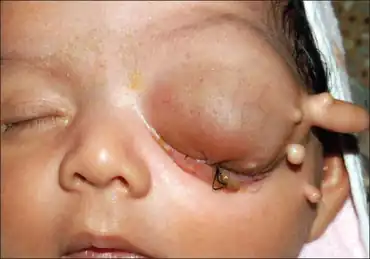Oculocerebrocutaneous syndrome
| Oculocerebrocutaneous syndrome | |
|---|---|
| Other names: Delleman–Oorthuys syndrome[1] | |
 | |
| Individual with Oculocerebrocutaneous syndrome- One-month with congential cystic mass replacing the eyeball on left side with accessory periocular cystic appendages. | |
Oculocerebrocutaneous syndrome is a condition characterized by orbital cysts, microphthalmia, porencephaly, agenesis of the corpus callosum, and facial skin tags.[1]
Symptoms and signs
These include
- Skin lesions
- Hypoplastic or aplastic skin defects
- Pedunculated, hamartomatous or nodular skin appendages
- Eye lesions
- Cystic microphthalmia
- Brain lesions
- Forebrain anomalies
- Agenesis of the corpus callosum
- Enlarged lateral ventricles
- Interhemispheric cysts
- Hydrocephalus
- Polymicrogyria
- Periventricular nodular heterotopia
- Mid-hindbrain malformation
- Giant dysplastic tectum
- Absent cerebellar vermis
- Small cerebellar hemispheres
- Large posterior fossa fluid collections
- Forebrain anomalies
Genetics
This is not understood but it is suspected that the gene(s) responsible may lie on the X chromosome.
Diagnosis
Differential diagnosis
Management
Oculocerebrocutaneous syndrome treatment/management involve orbital cyst removal via aspiration/dissection from periocular region. Sclerosing therapy can be used for this condition[2]
Epidemiology
This is a rare condition with only 26 cases diagnosed by 2005.
There is a marked male preponderance.
See also
References
- 1 2 Rapini, Ronald P.; Bolognia, Jean L.; Jorizzo, Joseph L. (2007). Dermatology: 2-Volume Set. St. Louis: Mosby. ISBN 978-1-4160-2999-1.
- ↑ RESERVED, INSERM US14-- ALL RIGHTS. "Orphanet: Oculocerebrocutaneous syndrome". www.orpha.net. Archived from the original on 5 September 2021. Retrieved 4 September 2021.
External links
| Classification |
|---|
This article is issued from Wmcloud. The text is licensed under Creative Commons - Attribution - Sharealike. Additional terms may apply for the media files.